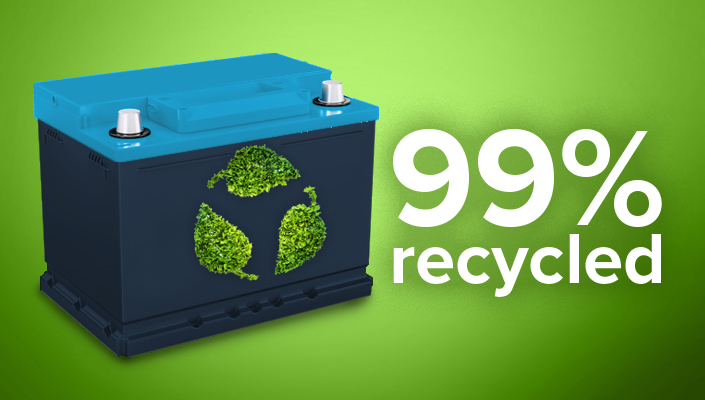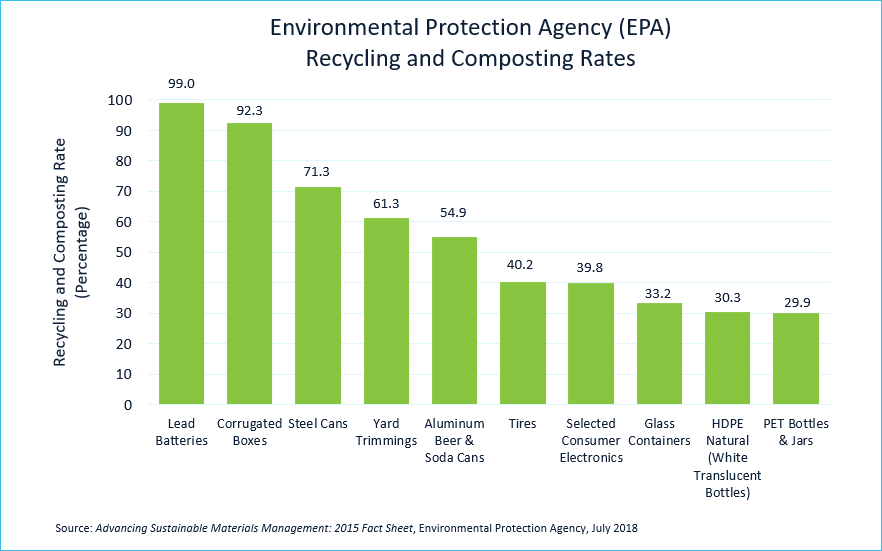
To celebrate America Recycles Day on Nov. 15, we’re proud to share great news: 99% of lead batteries are recycled. That key finding is from a new biennial study just released by Battery Council International (BCI) and Essential Energy Everyday.
The report, titled “BCI National Recycling Rate Study,” factors in years 2014–2018. According to the Environmental Protection Agency (EPA), this nearly 100% recycle rate means that lead batteries are the most recycled consumer product in the U.S.[1]
Here’s how lead batteries compare to more commonly recognized household recyclables, such as aluminum cans (54.9%) and glass containers (33.2%).

A Closed-Loop System
The lead battery success story is grounded in the industry’s nationwide lead battery and recycling infrastructure designed to recycle, reuse and remanufacture the primary components of a battery: plastic, acid and lead. The closed-loop system is not only a model of recycling, but the world’s most successful example of a circular economy, as noted by the World Economic Forum and MIT’s Center for Transportation and Logistics. That success equates as:
- Nearly 100% of spent lead batteries in the U.S. are recycled.
- More than 129 million lead batteries are recycled every year and kept from landfills.
- A new lead battery is typically comprised of more than 80% recycled material, and the lead in lead batteries is infinitely recyclable.
- Lead batteries are manufactured primarily from domestically sourced materials, which contributes to our national security.
Essential Lead Batteries
Growing demand for energy storage makes the circularity and sustainability of lead batteries even more important. More than 70% of the world’s growing rechargeable energy storage needs are met by lead batteries. This translates to more than one billion vehicles globally that rely on lead batteries for power, including every mass-produced hybrid and full electric vehicle.
Lead batteries also support a $1 trillion communications infrastructure in the U.S. As telecom and data centers grow to keep us connected – and with the rise in 4G and 5G – there will be increased demand for new equipment and infrastructure. Both lead and lithium batteries will supply this effort, with the projected market increase to be $1 billion in the two markets combined.
Lithium Recycling Lags
While both battery technologies will have their place, the 99% recycling rate of lead batteries is a dramatic contrast to the fewer than 5% of lithium-ion batteries that are currently recycled. There are many efforts under way to solve the lithium recycling dilemma, including a $5 million prize offered by the U.S. Department of Energy. But until that’s resolved, lead batteries remain the greener solution.
Update: America Recycles Pledge
In February 2019, BCI joined more than 160 other organizations in signing the America Recycles Pledge to work toward a more resilient materials economy. To celebrate the culmination of that work, EPA is hosting its second annual America Recycling Day Summit at EPA headquarters in Washington, D.C., on November 15. We look forward to EPA Administrator Andrew Wheeler discussing additional ways to strengthen the U.S. recycling infrastructure.
[1]https://www.epa.gov/sites/production/files/2018-07/documents/2015_smm_msw_factsheet_07242018_fnl_508_002.pdf, pg. 10.
Learn More
Recycling Information & Study
News Release: Lead Battery Industry Issues New National Recycling Rate Study
EPA America Recycles Pledge


